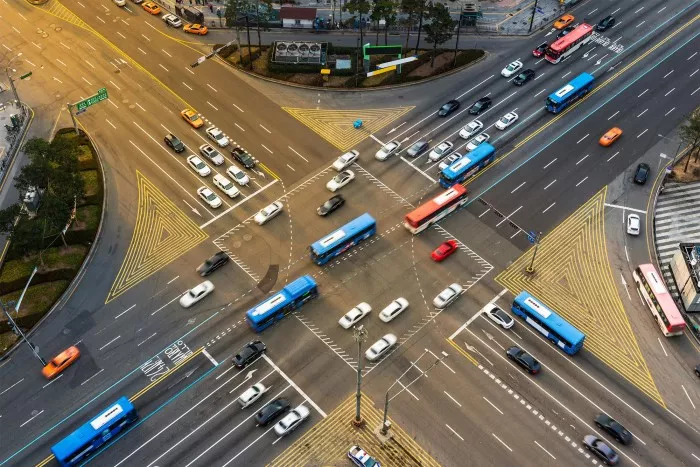No one likes to wait at a red light. However, intersections with signal lights are not only a little trouble for drivers, but also waste fuel and emit greenhouse gases when waiting for the signal lights to change. What if drivers could accurately schedule their journeys so that they could pass the traffic lights directly every time?

Although this may only happen when human drivers are particularly lucky, it can also be achieved more stably by autonomous vehicles that use AI to control their speed.
In a new study, scientists at the Massachusetts Institute of Technology (MIT) demonstrated a method of machine learning. This method can learn to control a group of autonomous vehicles and keep the traffic smooth when they approach and pass a signalized intersection.
According to the simulation results, their method can reduce fuel consumption and emissions, while increasing the average speed. If all the cars on the road are autonomous, the technology will get the best results, but even if only 25% of the cars use their control algorithm, it will still bring huge fuel and emission benefits.
"This is a very interesting place that can be intervened. No one's life will be better because they are blocked at a crossroads. There is an expected difference in quality of life among many other climate change interventions, so there is a barrier to entry," said Cathy Wu, senior author of the study. It is reported that he is Gilbert W. Winslow assistant professor of career development in the Department of civil and environmental engineering, and a member of the Institute of data, systems and Society (IDSS) and the laboratory of information and decision systems (lids).
Lids and vindula jayawardana, a graduate student in the Department of electrical engineering and computer science, are the first authors of the research paper. The study will be presented at the European control conference.
Intricate crossroads
Although human beings may pass green lights without thinking, there may be billions of different situations at intersections, depending on the number of lanes, the operation mode of signal lights, the number and speed of vehicles, the presence of pedestrians and cyclists, and so on.
The typical method to solve the intersection control problem is to use mathematical model to solve a simple and ideal intersection. This may look good on paper, but it may not hold water in the real world because the traffic patterns there are often chaotic.
Wu and jayawardana think about this from a different angle. They use a model-free technology called deep reinforcement learning to deal with this problem. Reinforcement learning is a trial and error method, which controls algorithm learning to make a series of decisions. When it finds a good sequence, it will be rewarded. Through deep reinforcement learning, the algorithm uses the assumptions learned by the neural network to find a shortcut to a good sequence - even if there are billions of possibilities.
This is useful for solving long-term problems like this. Wu pointed out that the control algorithm must send more than 500 acceleration commands to the vehicle within a long period of time. In addition, she added, "and we must get the right order before we know that we have mitigated emissions well and reached the intersection at a good speed."
However, there is a problem that researchers want the system to learn a strategy to reduce fuel consumption and limit the impact on travel time. These goals may be conflicting.
"In order to reduce travel time, we want the car to drive fast, but in order to reduce emissions, we want the car to slow down or not move at all. These competing rewards may confuse learning agents," Wu said.
Although the universality of solving this problem is challenging, researchers have adopted a technique called reward shaping to adapt. Through reward shaping, they give the system some domain knowledge that it cannot learn by itself. In this case, whenever the vehicle comes to a complete stop, they punish the system so that it can learn to avoid this behavior.
Traffic test
Once researchers have developed an effective control algorithm, they will use a traffic simulation platform with a single intersection to evaluate it. The control algorithm is applied to a fleet composed of networked autonomous vehicles, which can communicate with the upcoming traffic lights to receive the phase and time information of the lights and observe their surrounding environment. The control algorithm tells each vehicle how to accelerate and decelerate.
When vehicles approached the intersection, their system did not cause any stop and go traffic. In the simulation, more cars pass through the single green light stage, which is more than the model simulating human drivers. When compared with other optimization methods that also aim to avoid stop and go traffic, their technology brings greater fuel consumption and emission reduction. If every car on the road is autonomous, their control system can reduce fuel consumption by 18% and carbon dioxide emissions by 25%, while increasing driving speed by 20%.
Wu said: "it is really incredible that a single intervention can reduce fuel or emissions by 20% to 25%. But what I find interesting is that what I really want to see is this non-linear proportion. If we only control 25% of the vehicles, it will bring us 50% of the benefits of fuel and emissions reduction. This means that we do not have to wait until we reach 100% of the autonomous vehicles to benefit from this method."
Next, researchers hope to study the interaction effect between multiple intersections. In addition, they also plan to explore how different intersection settings such as the number of lanes, signal lights and timing affect travel time, emissions and fuel consumption. In addition, they intend to study how their control systems affect safety when autonomous vehicles share roads with human drivers.
Although this work is still at an early stage, Wu believes that this method can be more feasible in the near future.